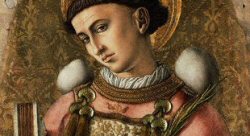Since this article was published before the Holy Father's visit, it does not contain the following very important element about marriage and family life from Pope Benedict's address to the Bishop's of the United States:
"In this regard, a matter of deep concern to us all is the state of the family within society. Indeed, Cardinal George mentioned earlier that you have included the strengthening of marriage and family life among the priorities for your attention over the next few years. In this year’s World Day of Peace Message I spoke of the essential contribution that healthy family life makes to peace within and between nations. In the family home we experience “some of the fundamental elements of peace: justice and love between brothers and sisters, the role of authority expressed by parents, loving concern for the members who are weaker because of youth, sickness or old age, mutual help in the necessities of life, readiness to accept others and, if necessary, to forgive them” (no. 3). The family is also the primary place for evangelization, for passing on the faith, for helping young people to appreciate the importance of religious practice and Sunday observance. How can we not be dismayed as we observe the sharp decline of the family as a basic element of Church and society? Divorce and infidelity have increased, and many young men and women are choosing to postpone marriage or to forego it altogether. To some young Catholics, the sacramental bond of marriage seems scarcely distinguishable from a civil bond, or even a purely informal and open-ended arrangement to live with another person. Hence we have an alarming decrease in the number of Catholic marriages in the United States together with an increase in cohabitation, in which the Christ-like mutual self-giving of spouses, sealed by a public promise to live out the demands of an indissoluble lifelong commitment, is simply absent. In such circumstances, children are denied the secure environment that they need in order truly to flourish as human beings, and society is denied the stable building blocks which it requires if the cohesion and moral focus of the community are to be maintained.
As my predecessor, Pope John Paul II taught, “The person principally responsible in the Diocese for the pastoral care of the family is the Bishop ... he must devote to it personal interest, care, time, personnel and resources, but above all personal support for the families and for all those who … assist him in the pastoral care of the family” (Familiaris Consortio, 73). It is your task to proclaim boldly the arguments from faith and reason in favor of the institution of marriage, understood as a lifelong commitment between a man and a woman, open to the transmission of life. This message should resonate with people today, because it is essentially an unconditional and unreserved “yes” to life, a “yes” to love, and a “yes” to the aspirations at the heart of our common humanity, as we strive to fulfill our deep yearning for intimacy with others and with the Lord."
From Mercator.net
 As the Pope begins his visit to the United States there is one topic he is certain to speak on.
As the Pope begins his visit to the United States there is one topic he is certain to speak on.By Megan Gallagher
Tuesday, 15 April 2008
A new analysis carried out by myself and Joshua Baker entitled Pope Benedict XVI on Marriage: A Compendium and published by the Institute for Marriage and Public Policy on the eve of Benedict's historic U.S. visit, finds that in less than three years of his pontificate, Pope Benedict XVI has spoken publicly about marriage on 111 occasions. His pronouncements connect marriage to such overarching themes as human rights, world peace, and the conversation between faith and reason.
Over and over again he has made it clear that the marriage and family debate is central -- not peripheral -- to understanding the human person, and defending our human dignity.
For example, when receiving the credentials of the new U.S. Ambassador to the Vatican, Harvard Law Professor Mary Ann Glendon, Pope Benedict XVI expressed his appreciation for America's recognition of the important of a dialogue of faith and faiths in the public square and linked this to respect not only for religious freedom but for marriage as the union of husband and wife:
"I cannot fail to note with gratitude the importance which the United States has attributed to interreligious and intercultural dialogue as a positive force for peacemaking. . . The American people's historic appreciation of the role of religion in shaping public discourse and in shedding light on the inherent moral dimension of social issues-a role at times contested in the name of a straitened understanding of political life and public discourse-is reflected in the efforts of so many of your fellow-citizens and government leaders to ensure legal protection for God's gift of life from conception to natural death, and the safeguarding of the institution of marriage, acknowledged as a stable union between a man and a woman, and that of the family."
Pope Benedict devoted about half of his message for the January 1 World Day of Peace to the significance of marriage in developing a culture of peace:
"Consequently, whoever, even unknowingly, circumvents the institution of the family undermines peace in the entire community, national and international, since he weakens what is in effect the primary agency of peace. This point merits special reflection: everything that serves to weaken the family based on the marriage of a man and a woman, everything that directly or indirectly stands in the way of its openness to the responsible acceptance of a new life, everything that obstructs its right to be primarily responsible for the education of its children, constitutes an objective obstacle on the road to peace."
Marriage essential to world peace? This may strike American ears as an oddity. If so Benedict has made clear it is not an unintentional one. On September21, 2007, in an address to participants in a conference of the Executive Committee of Centrist Democratic International, Pope Benedict prefigured the same theme:
"There are those who maintain that human reason is incapable of grasping the truth, and therefore of pursuing the good that corresponds to personal dignity. There are some who believe that it is legitimate to destroy human life in its earliest or final stages. Equally troubling is the growing crisis of the family, which is the fundamental nucleus of society based on the indissoluble bond of marriage between a man and a woman. Experience has shown that when the truth about man is subverted or the foundation of the family undermined, peace itself is threatened and the rule of law is compromised, leading inevitably to forms of injustice and violence."
The short pontificate of Benedict XVI is already a standing rebuke to those voices of our time who seek to make us ashamed or embarrassed of caring about marriage and sexual issues, who try to get us to view the contemporary marriage debate as merely a distraction from more important issues. Pope Benedict clearly connects life and marriage, the human person in the human family, with the most fundamental international issues of peace and human rights facing our times.
Maggie Gallagher is president of the Institute for Marriage and Public Policy.

















.JPG)


























